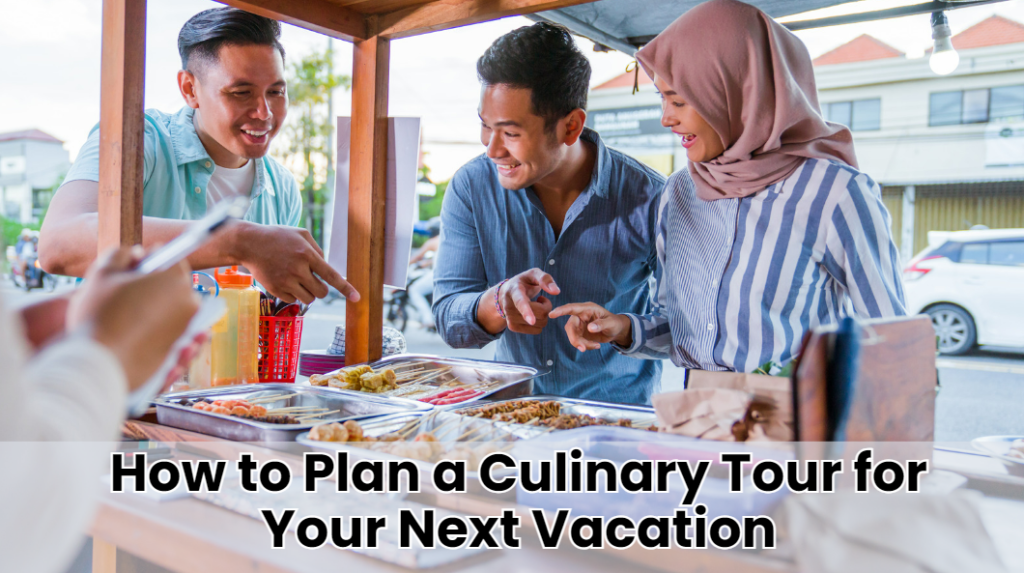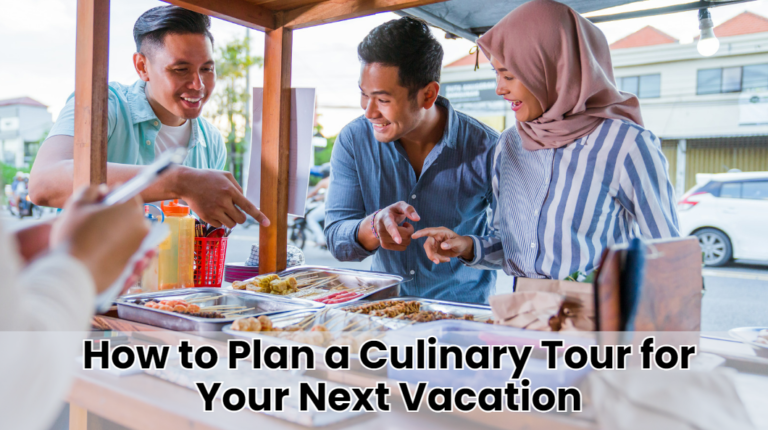Food is an integral part of travel, providing a window into the culture and traditions of a destination. The food tour is an unforgettable experience, offering hidden gastronomic treasures of the region and people’s attitudes towards local cuisine.
If you believe going on a culinary tour will be your next vacation, here is everything you need to plan the perfect trip: how you can make the most of your foodie tour and some practical advice on travel essentials.

Choose Your Destination Wisely
The success of any culinary tour begins with choosing a destination. Many regions are renowned for their food, offering unique culinary experiences. Whether it’s traditional dishes, diverse street foods, or haute cuisine, every region has something unique to present.
Look for places offering diverse experiences, from street food to fine dining, that align with your interests and dietary needs. Factor in the destination’s cultural context, as food often reflects local history and lifestyle. Practical considerations are crucial to – assess transportation options, language barriers, and connectivity.
Planning a culinary tour for your next vacation can be an enriching experience, especially if you’re heading to a destination like Italy. To make the most of your trip, consider researching and mapping out the best food regions, from Tuscany’s wine and olive oil to Naples’ iconic pizza. Staying connected during your journey is essential for discovering hidden gems and making reservations at top restaurants.
Using the best esim italy has to offer ensures you have reliable internet access wherever you go, allowing you to look up reviews, get directions, and even book last-minute experiences without the hassle of finding Wi-Fi.
Research Local Cuisine and Specialties
After choosing a destination, research the local specialties and cuisine. Make a list of must-try dishes and food markets that offer authentic experiences. Look for food festivals, cooking classes, and guided food tours that can give you insider knowledge and enhance your gourmet exploration.
To enrich your experience, understand the cultural context of the cuisine, and consult local food guides or blogs. Stay open to spontaneous discoveries, as some of the best culinary experiences are often unplanned.
For example, each region has flavors and ways of preparing food that are unique to them. You should research ahead of time so that you can be sure you aren’t missing anything important related to food.
Plan Your Itinerary
With a good understanding of the local food, start planning your tour. Allow time to visit markets, eat at popular local spots, and participate in cooking lessons. Balance your schedule with fine dining experiences and casual street food tours.
Include time for cooking classes or workshops to learn from local chefs. Balance your schedule with a mix of planned activities and free time to explore spontaneously. Ensure your itinerary flows geographically, minimizing travel time between stops, and always leave room for unexpected culinary discoveries along the way.
For example, you could dedicate one day to wine tasting, another to pasta-making lessons, and several days to exploring local markets and traditional eateries. These varied experiences will provide a deeper food experience and enhance your appreciation of the region’s food culture.
Book Culinary Experiences in Advance
Book in advance and reserve popular food experiences: top-rated restaurant reservations, general food tour places, and space in cooking classes. Many culinary experiences are highly in demand, so making early reservations also ensures that you won’t be left out of a preferred activity.
This may include booking wine-tasting tours or cooking lessons in small villages. Give yourself time to secure these reservations and enjoy specialized activities without last-minute stress.
Consider Dietary Restrictions and Preferences
When planning a gastronomic tour, food allergies or aversions are important to consider. Select destinations and activities that will accommodate you. Call ahead to restaurants, food tours, and cooking classes to talk about special needs.
If you are going to visit a region whose cuisine greatly features seafood, dairy products, or gluten and you have some special needs in your diet, please let your hosts know. Most places will accommodate any dietary restrictions provided that advance notice is given.
Learn Basic Local Food Vocabulary
Learning some phrases in the local language about food and eating can enhance the experience of a culinary tour immensely. You will be able to ask for recommendations, understand menus, and express preferences-that is how it’ll turn out smooth and enjoyable.
Knowing how to say “delicious” or ask for recommendations in the local language can make dining more enjoyable and immerse you further in local culinary traditions.
Pack Smart for Your Culinary Tour
Packing the right things will make your gastronomic tour very comfortable and easy. Of course, you will have to pack comfortable walking shoes since you’re most likely to do some market shopping and dining here and there. You may also want to bring a refillable water bottle, a small notebook to jot down recipes or recommendations, and a camera to document the food you eat.
Pack clothes suitable for various dining scenarios, from casual to formal. Having adaptable outfits will prepare you for different eating environments you might encounter.
Be Open to New Experiences
| Action | Purpose | Benefits |
| Take Ample Pictures | Capture visuals of everything related to food. | Allows you to relive your experience and share memorable moments with friends and family. |
| Take Notes | Document details of dishes, recipes, and experiences. | Helps you remember specific culinary experiences and insights for future reference. |
| Write a Travel Blog or Social Media Posts | Share your experiences with a wider audience. | Inspires future travelers and provides a platform to showcase your culinary journey. |
| Enjoy Every Meal | Savor each dish and take your time to relish the flavors. | Enhances your overall enjoyment and appreciation of the food and cultural experience. |
| Document Food Scenes | Capture moments at markets, cooking classes, and dining settings. | Preserve the lively and diverse aspects of your culinary tour, making it more memorable and special. |
Conclusion
Planning a culinary tour for the next vacation can be a pretty enriching experience. From choosing a destination to researching the local food to pre-bookings of key experiences, every effort made towards creating lifelong memories is worthy and will keep your senses filled with the delight of taste and the aura of the place you decide to go to.
Remember to keep yourself connected with all modern conveniences like eSIM technology, open up to new culinary adventures, and savor every moment of your gastronomic exploration. Happy travels and bon appétit!
FAQs
What is a culinary tour?
A culinary tour is a travel experience focused on exploring a region’s food and drink. It typically includes activities like visiting local markets, restaurants, and food producers, taking cooking classes, and participating in food tastings.
How long should a culinary tour be?
The length can vary based on your preferences and the destination. A weekend can be enough for a local food scene, while international culinary tours often range from one to two weeks for a more experience.
What should I pack for a culinary tour?
Essential items include comfortable walking shoes, clothing suitable for various dining settings, a camera or smartphone for food photography, a small notebook for recipes or tasting notes, and any personal dietary items you might need.

